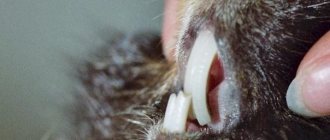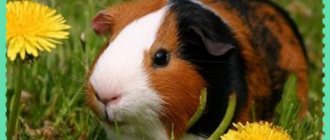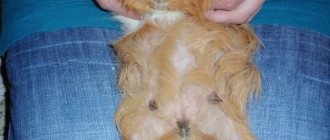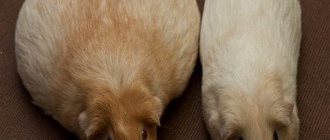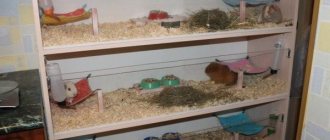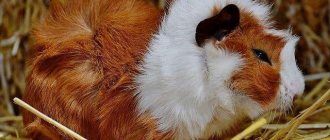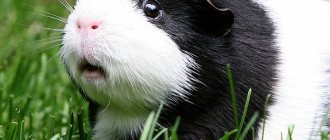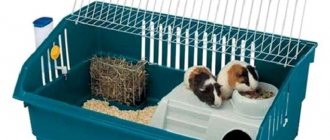Brittle teeth in guinea pigs are a natural phenomenon. Partially or even completely broken incisors grow back in 2-3 weeks. True, while they are growing, the animal may experience pain and discomfort when eating solid food. The animal will eat hay and grass without any problems, but it will have to grate root vegetables. In addition, grain and dry food should be excluded from the pet’s diet during this period.
A more unpleasant problem is the chipping of the cutter. Your pig's chipped teeth will wear down unevenly unless you contact your veterinarian for artificial grinding.
Dental problems in guinea pigs are not uncommon. These animals are characterized by malocclusion, dental diseases, falling out teeth, broken teeth, and inflammation of the mucous membrane. All this causes concern among owners. However, not all of the above problems lead to sad consequences, some are easily solved, and some even go away on their own.
How many teeth does a guinea pig have?
All pigs, regardless of species and breeds, have the same jaw structure. You need to know that the number of teeth of a guinea pig is 20. They have the peculiarity of constantly growing. Their length is corrected by the ability to constantly gnaw or chew something. Constant growth and their correction inherent in nature allows the animal to keep its teeth, otherwise it would not have them after a year of life. They do not have a constant length. The shape of the top edge changes. It all depends on the food he eats. If everything is chosen rationally, there is no need to worry. Their length will adjust on its own.
She has no fangs. The uniqueness of guinea pigs' teeth is that they have a diastema - space between the incisors and premolars. On the jaws – upper and lower – there are the same number: 2 incisors below and 2 above, also 2 premolars and 3 molars. Molars, having an open root, grow continuously throughout life so that the length of the teeth is worn down to normal. After all, animals are constantly chewing something, grinding hard food, hay, grass, twigs.
Diagnostics
The initial examination takes place without anesthesia. An assistant gently holds the guinea pig while the veterinarian examines the oral cavity. If there are obvious painful symptoms, the rodent is examined under general anesthesia. The doctor feels the cheeks and takes an X-ray of the jaws. This is how root growth is detected, because visually everything is normal, but it hurts the pig to chew.
Structures of the jaws and teeth of a guinea pig
The incisors are large, the lower front teeth are always larger, and the upper ones are smaller. The lower incisors are slightly convex, the upper front ones are slightly concave. The incisors should not close together. This indicates that the bite is correct and there is space vertically and horizontally. The outer side of the front teeth is covered with enamel. It is not on the inner surface and erasing is much faster. Incisors increase the cutting surface. The cheek teeth are slightly tuberous. They do not have roots as such. This feature promotes the constant growth of crowns and roots - reserve crowns.
The lower jaw moves in all directions according to the principle of a knife. After all, solid food needs to be cut into small pieces, which the pig does by biting off the required portion with the upper jaw.
Normal dental condition
- It is considered normal if the lower incisors are about 1 cm long, the upper ones should always be shorter - 0.6–0.7 cm. Keep an eye on these parameters.
- There should be gaps between the incisors vertically and horizontally; they should not overlap.
- The lower jaw extends under the upper jaw by 2–3 mm.
- Erasure and regrowth proceed evenly.
Remember! With a balanced diet, the pig feels well, the front teeth are ground down to the required level while eating. No veterinary intervention is needed.
Symptoms of dental disease in guinea pigs
- Unusual chewing, spitting out food or as if it is going up;
- when chewing, the ears move strongly;
- saliva flows, which may contain blood due to damage to the gums, the fur around the mouth is wet;
- chews on one side and slowly, unchewed pieces fall from the mouth;
- Chews hard food longer than soft food;
- the incisors are inclined to one side, the upper ones protrude from the mouth;
- the ears and nose are full of mucus that flows, there are tears in the eyes, they swell, the eyeball enlarges, because the soft tissues near the eyes and nasal sinuses can be injured by teeth growing into them, the animal’s muzzle is distorted due to upper or mandibular abscesses;
- She has lost weight, doesn’t eat food, only sniffs.
Enamel implantation with Innodent
The procedure is new, but has already proven itself as an effective method for restoring tooth enamel .
- Painlessly cures caries in 1 month
- Relieves tooth sensitivity
- Removes white spots after braces
- Strengthens and mineralizes enamel
Description of the procedure:
Innodent is applied to the tooth surface, which in turn is integrated into the enamel structure at the molecular level. This is achieved through active substances whose characteristics coincide with dental tissues.
Main results:
Cracks and damage to the enamel are completely eliminated, the integrity of the tooth enamel is restored and the process of regeneration of the natural structure begins.
When will the results of the procedure be visible?
You will see the first results 3 days after the start of the procedure, but the process of tooth enamel regeneration itself can last 1-1.5 months. A decrease in the sensitivity of enamel to mechanical and temperature stimuli also occurs gradually. In individual cases, it is possible to re-use the drug after 3-4 months.
Indications for the dental enamel implantation procedure
Below we will describe the main indications for which enamel implantation will be the most effective restoration method.
- High sensitivity of teeth (temperature and mechanical)
- Damage (chips) and cracks in tooth enamel
- Wedge-shaped defect (hyperplasia)
- Tendency of teeth to the spread of caries
- Pigment spots on the surface of tooth enamel
- At the initial stage of caries spread
An important feature of the drug is the possibility of use for preventive purposes, as well as in conjunction with teeth whitening procedures. Effectively copes with the treatment of enamel demineralization. It is possible to carry out the procedure after correction with braces in order to eliminate age spots on the surface of the enamel.
Are there any contraindications to the procedure?
The procedure is completely safe and has no contraindications as such. However, in rare cases, the following are possible: an allergic reaction and individual intolerance to one or more components of Innodent. You should not carry out the procedure with major damage to the internal tissues of the tooth.
Pros and cons of dental enamel implantation with Innodent
Main advantages:
- High degree of safety and natural ingredients
- Suitable for pregnant women and children (including baby teeth)
- As a result, you get smooth enamel with a natural shade
- Stains and damage are completely eliminated within a month
- Can be used at the initial stage of caries development and thereby avoid drilling and filling teeth
- Complete painlessness and absence of discomfort for the patient at all stages of the procedure
- The procedure is quick - about 15-25 minutes for everything
- The result lasts really long (from 1 to 3 years)
Flaws:
- Price - the method is not the cheapest, but in terms of price-quality ratio it has no analogues
- Really good results are possible a month after the procedure
- Does not solve the problem with large defects (internal tooth decay)
Dental implantation with the help of Innodent has allowed modern dentistry to truly restore enamel, and not replace it with temporary solutions.
A completely new approach to enamel restoration
Causes of dental problems
They don't have caries. But they can have malocclusion, just like people. This happens from a genetic mutation. Therefore, if you plan to breed pigs, do not mate relatives.
Pigs have dental problems. The causes of the disease are different: they crumble and break when they chew on their cage. This happens when there are no solid foods in the diet that allow them to be undermined. Food that is easily chewed aggravates the problem of incisor growth; natural grinding is disrupted, they grow unevenly, grow much longer than normal, cut into the mucous membrane of the cheeks, provoking inflammation.
The bite affects the lengthening of the front teeth, or incisors along with the lateral ones. Then it is difficult to eat, and her health worsens.
If they grow larger than normal, they can injure the mouth by growing into the cheeks or tongue.
Remember! Sometimes they seem very large, but this may be an individual feature and has nothing to do with malocclusion.
Please note: when an animal falls, the teeth can become dislodged and injure the mucous or soft tissues of the mouth. Sometimes they wear down so quickly that they don't have time to grow. This is the reason for the lack of vitamin C. If they break or crumble, there is not enough calcium. Fast-growing roots indicate that the animal is eating green grass or hay that has been treated with herbicides. They contain fluoride, which is not quickly removed from the body and leads to lengthening of tooth roots. Old age may also cause them to shift, and then you will have to syringe-feed them liquid food for the rest of your days.
If multiple symptoms are present, diagnosis is much quicker. You need to contact a veterinarian who will examine the oral cavity and take an x-ray of the jaw. If there are pain symptoms, general anesthesia will be given.
Teeth trimming at home around the clock
Teeth trimming is a painful procedure and is therefore most often performed under anesthesia.
Experienced ratologists perform it both in a veterinary clinic and at home. In some cases, when anesthesia is contraindicated, the doctor acts without it, using special tools, acting quickly and accurately.
It is important to choose the right length - do not cut the teeth too short, otherwise the pet will not be able to feed on its own.
In this regard, you should not try to trim the teeth yourself - this can lead to serious health problems for the animal.
Do not trust instructions on the Internet - contact our veterinary center to receive qualified care in the hospital and at home.
Dental pathologies in guinea pigs
Injuries
When it falls, teeth can break without damaging the crown. They get injured when they chew on the iron bars of a cage without branches. Make sure that the oral mucosa is not injured by them on the opposite side, so that stomatitis does not develop.
Inflammation and suppuration occur if the gums bleed, touched by the uneven sharp edges of a broken tooth, which continues to crumble and there is a threat of its complete loss. A visit to the veterinarian is necessary to solve problems:
- their pruning;
- broken upper teeth;
- there is an unpleasant odor from the mouth.
Using special bone forceps and under anesthesia, the doctor will smooth out sharp irregularities. After the procedures, you cannot eat. For feeding, use a syringe without a needle, filling it with grated vegetables. Soft food and calcium a quarter or 1/3 tablet, and vitamin C must be given for at least the first fourteen days.
Adding vitamins to food will stop them from wobbling and crumbling.
Sometimes the pig knocks its teeth on the metal bars of the cage, and there is a danger of breaking them or the jaw. To prevent their damage and weakness, you need to review your diet by adding vitamins C and D.
The reason for the knocking may be the elongation of the incisors and she wants to reduce them, and using the capabilities that she has, she grinds them down. She may also feel discomfort or pain in the abdominal area and pound, wanting to get rid of it. Knocking may indicate her dissatisfaction.
When there are no sharp ends in the broken tooth, there is no need to bother the veterinarian. Give a quarter of a 100 mg vitamin C tablet every day.
When your guinea pig grinds its teeth, you should watch it. The reason may be dissatisfaction, pain, infection, or difficulty eating. Weigh her every week and if her body weight decreases and the grinding does not stop, you need to go to the vet.
When a pig clicks its teeth, it doesn't like something at all, it's scared or angry.
Cheilitis
Pigs suffer from cheilitis. The disease affects the gums and oral mucosa, where cracks form. Hard deposits appear around the tooth roots, which are formed from yellowish or brown plaque that accumulates between them. The teeth diverge to the sides.
The main causes of infection can be a virus, a fungus, from food, an allergy to dust that is in the hay, upon contact, from an excess of vitamins or from a lack of pantothenic acid, vitamins A and C, when the diet is unbalanced.
There are two options for treating dental cheilitis: nutrition and medication.
It is necessary to reconsider the composition and standards of nutrition. Do not give sour and sweet and sour fruits and vegetables for some time. Give preference to twigs, dry herbs, and vegetables that have almost no juice. To ensure that your food contains various vitamins, give 3-4 pieces of peeled sunflower seeds, half a teaspoon of flax seeds. Moisten the food with drops of sesame oil.
Before starting drug treatment, a special test is taken - a scraping. Cheilitis on teeth and skin is treated differently. It is prohibited to use dental ointments or creams on the skin and vice versa. Every day, morning and evening, treat the oral cavity with drugs that people use to treat fungus, thrush or cheilitis. Candida ointment has good reviews for the treatment of dental cheilitis.
Before applying ointment or cream, treat the affected area with an antiseptic or herbal decoctions that have these properties. Teeth cheilitis can be caused by fungus. Use medications against fungi in the mouth.
Take the animal out into the fresh air and sunlight.
You need to treat for two weeks or a little more, depending on the cure.
Tooth loss
When your pig's upper tooth falls out, there is no need to worry. She sometimes loses them. The physiological norm is no more than two. Within a half-month or a little more, new ones grow; in young pigs, all dairy products fall out before 10–12 months. If at the same time your appetite decreases, then reconsider your diet, do not allow you to eat solid food, grain, but only pureed fruits and vegetables.
If the loss is intense, more than 3 at a time, both from below and from above, you need to go to the veterinarian.
The cause may be an inflammatory process on the gums or a lack of calcium salts in the body.
Malocclusion
With malocclusion, there is a malocclusion. Due to pathology, very rapid growth of the anterior and cheek teeth. The reason may be an infection, a genetic disease or a dietary disorder. The incisors grow very long and look protruding.
There is a curvature of the muzzle due to a displacement of the jaw. The sharp edges of the back teeth grow into the uvula through the rapidly growing lower molars. The development of stomatitis, suppuration, gumboil and other troubles can be caused by upper molars growing towards the cheeks.
Due to the cause of the constantly open mouth, the animal cannot eat. This is accompanied by increased salivation, sometimes with blood particles, and weight loss.
The anterior ones can also grow back with pathological changes. You can't do without a veterinarian. The oral cavity is examined and X-rays are taken. After all, therapeutic procedures are prescribed.
Treatment of stomatitis occurs as follows: the pig’s oral cavity is sprayed with antiseptic solutions or herbal decoctions that are intended to treat inflammation.
The flux must be opened surgically. Teeth that are larger than normal are ground down and polished under anesthesia.
Tooth root lengthening
Pathology occurs when the roots, which are the reserve or subgingival part of the crown, become greatly elongated and grow into the periocular space and nasal sinuses. This is accompanied by pain, there is no appetite, rapid weight loss occurs, mucus flows from the nose and eyes, swelling and gumboils form, the orbit of the eyes changes towards enlargement and the pig’s muzzle has a crooked appearance.
You need to contact a veterinarian. The pathology is treated after X-ray images of the jaw are taken. The roots are reduced when the doctor trims crowns that have grown too much. They are removed only when the disease is very advanced.
When teeth are too long and even hard food does not stop the very rapid growth of incisors, premolars and molars, this becomes a problem. It is impossible to bite and chew. When they grow faster than the grinding process, you need to regularly - once a month or a little faster - go to the veterinarian to have them filed down.
When do you need veterinary help?
Contact a specialist with any questions regarding the condition of our little brothers. It is better to get professional advice in time and quickly begin treatment in order to help your pet as quickly as possible. In some cases, a visit to the veterinarian must be urgent. This depends on the condition of the guinea pig and the problem discovered by the owner.
For dental trauma
If the tooth is only slightly chipped, its edge is not too sharp, you don’t have to disturb the rodent, everything will grow back in 1-2 weeks. Just make sure your pig is eating normally and not losing weight. Also make sure that the remaining teeth do not injure the opposite cheek and gum.
But if the fragment is uneven, the tooth is broken too much or broken completely, visit the veterinarian. He will be able to provide the following assistance:
- Wash the wound in the gum with a saline solution (1 teaspoon of table salt per ½ liter of water) and teach you how to do this for independent use at home;
- grinds down the sharp edge of a broken tooth;
- will shorten other teeth so that they do not injure the oral cavity.
When extending roots
In rodents, tooth roots that are longer than normal cannot be externally determined. But they can cause malnutrition, and as a result, weight loss in the guinea pig. If you notice that your animal has lost weight, take it to the vet immediately. If no other cause of exhaustion is found, this assumption should be checked with x-rays.
If the elongation of the roots is confirmed in the image, you will need dental treatment (grinding) and an elastic bandage on the jaw.
Prevention of dental diseases
Carrying out preventive measures provides a solution to some problems:
- The presence of a diet with a predominance of solid feed, grain and hay. Give soft food and various delicacies in small doses. You cannot feed with the same products that you buy for yourself.
- When purchasing animals, check for congenital diseases.
- When setting up the cage, follow the rules to avoid falls and injuries.
- Do not keep two aggressive pigs in one cage.
- For pregnant females and young animals, enrich the diet with foods containing potassium and vitamins C and D.
- To be sure that the pig is not losing weight, weigh it once every 7 days.
- If you notice a reluctance to eat, increased salivation, or weight loss, you should contact a veterinarian.
In case of malocclusion and long roots, a tight elastic bandage applied at night helps. It compresses the jaw, the rodent resists, and as a result the muscles become stronger. The teeth they clenched begin to wear down. If this does not happen, you should contact your veterinarian to have the teeth filed and a bandage applied. After correction, the growth of incisors and molars becomes normal.
Your veterinarian will tell you how long to wear the bandage. In addition, a light jaw massage is prescribed for about 1.5 - 2 minutes on each side.
How to help your pet with its dental problems at home? Try to grab the broken tooth with your fingers and pull it out. The pig will survive this trouble. It hurts her more when it catches her gum and it starts to bleed. Don't be afraid, you won't be able to pull out the healthy one - it sits tightly, but the broken one will come out easily. The wound should be smeared with iodine. For some time the pig may not eat even soft food, then you can give it food using a syringe: 6 grams per 100 g of weight.
Symptoms
Alarm signals indicating the presence of a problem are changes in the behavior of the guinea pig and the nature of physiological functions:
- weight loss
- refusal to eat
- increased salivation (the animal “chomps” while eating), drooling
- inability to chew food normally (the animal drops pieces from the mouth)
- diarrhea (due to inability to chew hay and choosing soft foods)
- tearing while eating (because it hurts to chew)
- Lack of bowel movements or irregular bowel movements due to malnutrition
- increasing the duration of food intake (chews slower than usual)
Usually, all this indicates that a malocclusion has formed and the mumps needs urgent medical attention. If emergency treatment is not possible and your pet is unable to eat and is losing weight, you can feed him liquid food. To do this, feed granules need to be soaked in water until they become a paste. You can use a syringe for feeding, from which the part near the “spout” is cut off so that only the tube and the piston remain. This way you will save him from starvation.
Innodent Repair™
Manufacturer:
Bachem AG, Switzerland, according to GMP standards
Package:
1 bottle
Storage:
Store InnoDent™ Repair in the freezer (-15°C or below).
Transportation:
Delivery within the city without refrigerant in cold weather is allowed. During the warm season and when transporting long distances - delivery in polystyrene foam with refrigerant.
Innodent in dental practice.pdf Treatment of caries in children with InnoDent.pdf Swiss raw materials for the treatment of caries without pain
Submit your application
Installation of crowns
Prosthetics with crowns is a reasonable way to restore quality of life and restore the functionality of a severely damaged unit. Today it is possible to make beautiful and comfortable dentures at an affordable price.
